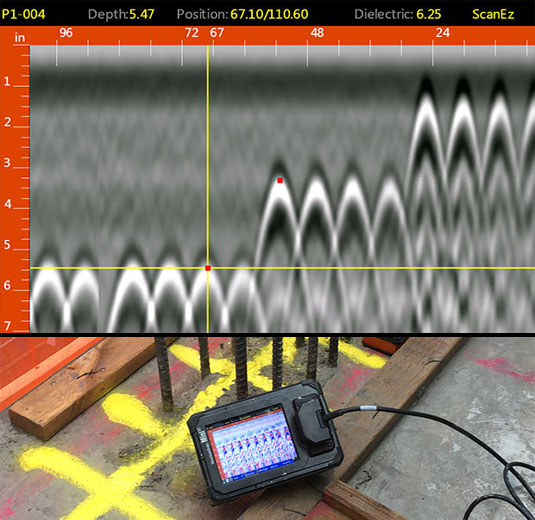Introduce the Transformative Power of Concrete Scanning in Maximizing Performance and Safety
Concrete scanning has actually emerged as a crucial tool in the construction sector, providing exceptional advantages in improving job effectiveness and guaranteeing security standards. The transformative power of concrete scanning lies in its capacity to supply real-time data and comprehensive insights, transforming how jobs are intended and implemented.
Importance of Concrete Scanning
Making certain the architectural honesty and safety and security of building and construction projects starts with the important step of conducting extensive concrete scanning. Concrete scanning is a non-destructive approach made use of to identify and map subsurface elements within concrete frameworks.
In addition, concrete scanning helps in enhancing task timelines and budget by preventing unexpected expenses and hold-ups that may arise due to unexpected blockages within the concrete. Ultimately, spending in comprehensive concrete scanning is a proactive technique that enhances both effectiveness and safety in building tasks.
How Concrete Scanning Functions
Concrete scanning operates as a crucial tool in building jobs by utilizing advanced modern technologies to discover and map subsurface components without creating structural damages. Ground Passing Through Radar (GPR) and Electromagnetic Induction (EMI) are two key methods used in concrete scanning. GPR jobs by emitting high-frequency radar pulses right into the surface, which recuperate when they experience subsurface things or voids. The time considered the signal to return shows the deepness and place of the objects. EMI, on the other hand, utilizes electro-magnetic fields to identify differences in material compositions, such as determining rebar or avenues within concrete frameworks.
During the scanning procedure, the information collected is assessed in real-time, enabling instant recognition of potential dangers or barriers beneath the surface area. By utilizing these sophisticated innovations, concrete scanning considerably decreases the danger of expensive damages and injuries on construction sites.
Benefits of Concrete Scanning
One of the key advantages of concrete scanning is the ability to identify and find ingrained objects such as rebar, post-tension wires, and channels accurately. Concrete scanning aids in planning and designing more effectively, as it provides specific details regarding the area and depth of architectural parts.

Study: Concrete Scanning Success

In an additional instance, a construction business used 3D concrete scanning to evaluate the read the article condition old concrete structures in a historical building. The detailed scans provided important understandings into the level of degeneration and helped focus on maintenance initiatives successfully. By proactively attending to locations of worry identified through scanning, the firm was able to expand the lifespan of the structure and make sure resident security.
These study emphasize the transformative power of concrete scanning in boosting performance, accuracy, and safety in building and construction tasks.
Executing Concrete Scanning in Projects
Carrying out innovative scanning modern technologies during building tasks has ended up being significantly necessary for enhancing accuracy and security. By incorporating concrete scanning into task planning and implementation, building and construction teams can recognize possible risks, such as rebar or post-tension cable televisions, hidden within concrete frameworks. This proactive technique reduces the danger of accidents, delays, and pricey rework, inevitably bring about a lot more effective job timelines and budgets.
To execute concrete scanning effectively, task supervisors should collaborate very closely with seasoned scanning specialists to determine the most ideal scanning strategies for the certain read here project needs. Involving scanning professionals from the onset of a job enables the group to produce thorough scanning strategies that resolve vital locations of problem and ensure complete information collection.
In addition, including concrete scanning right into normal job operations can streamline decision-making processes, as real-time scan data supplies instant insights right into the problem of concrete structures - Concrete Scanning. This data-driven strategy assists in educated problem-solving and enables teams to make modifications immediately, fostering a society of efficiency and security throughout the project lifecycle

Conclusion
In conclusion, concrete scanning plays a crucial duty in enhancing efficiency and safety and security in building tasks. By using advanced technology to map and spot out underlying frameworks within concrete, this process assists to stop pricey mistakes, make sure architectural integrity, and lessen dangers on website. With the capacity to uncover covert aspects and give exact data, concrete scanning confirms to be an important tool for enhancing project results and making best use of general success.
Concrete scanning is a non-destructive approach used to spot and map subsurface components within concrete frameworks. Additionally, concrete scanning assists in maximizing project timelines and budget by preventing unforeseen prices and delays that may emerge due to unexpected obstructions within the concrete. One noteworthy case research involves a massive remodelling task where concrete scanning played an important duty in guaranteeing job success.In another situation, a building and construction business used 3D concrete scanning to analyze the condition of maturing concrete structures in a historic structure. By incorporating concrete scanning right into discover this info here project planning and implementation, building and construction teams can determine potential dangers, such as rebar or post-tension cables, concealed within concrete frameworks.